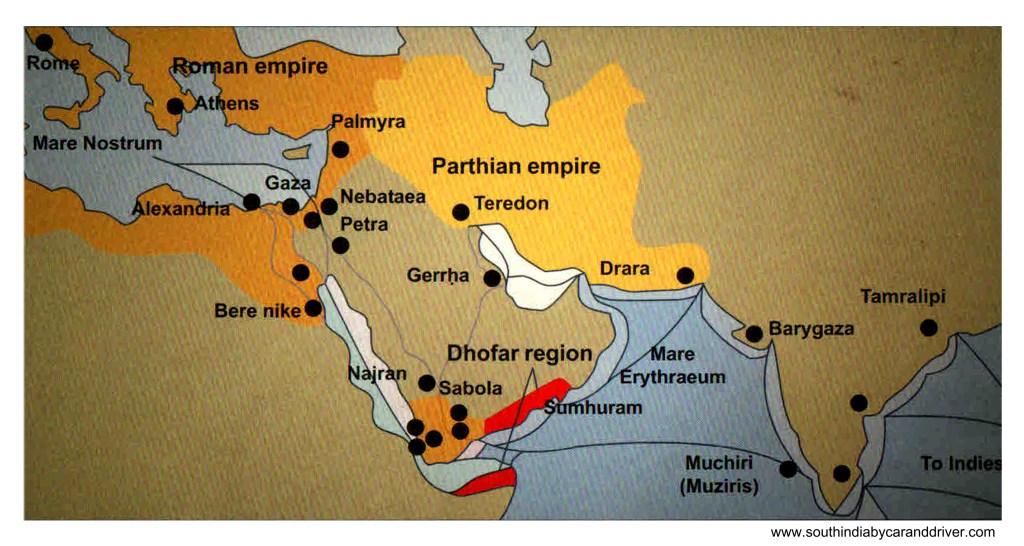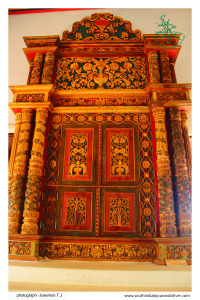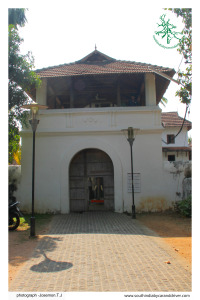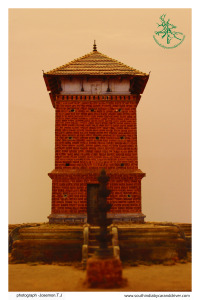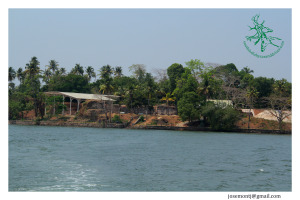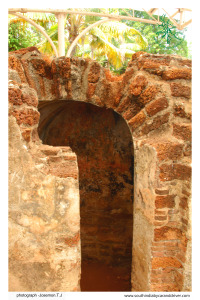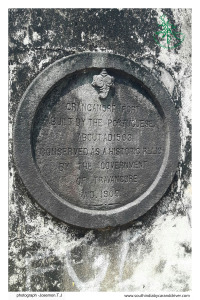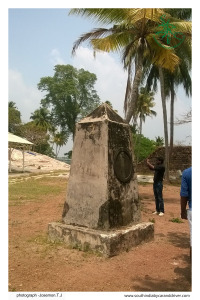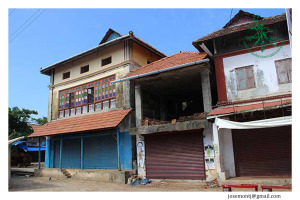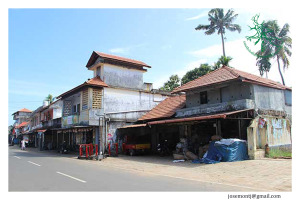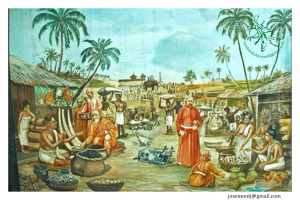Muziris was once the doorway to India for varied cultures and races including Jews, Romans, Portuguese, Dutch, Buddhists, Arabs, Chinese and the British. It has stood witness to civilisations being born, wars being waged and history being written. Did it begin with the spice trade ?
Spices have enticed the world since time memorial. As far back as 2600 BC there are records of the Egyptians feeding spices obtained from Asia to labourers building the Great Pyramid of Cheops in order to give theme strength.
Muziris was at the heart of the historic Spice Route, as shown on the following map of the routes that spices took during that pharaonic age.
But the legendary port vanished off the grid over 3000 years ago. Historians and archaeologists hunted far and wide in search of it but to no avail. Then, one day, it rained in Pattanam, a small town in Kerala. The rains unearthed and revealed to mankind remnants of a legacy. The legacy of the lost port, Muziris….
The ancient world’s greatest trading centre in the East, this legendary seaport traded in everything from spices to precious stones with the Greeks, Romans and the rest of the world. The Muziris Heritage Project will revive that lost legacy to conserve and showcase a culture of 3000 years or more for posterity.
Come… let us together clamber down the ladders of time to a past whose riddles await us. A past cloaked in the grandeur and glory of our ancestors…
1512 BC: Pharaonic age spice from the east used in the burial chambers of Egypt. Material evidence for this found in the wall of relief of the Day all Bahri funerary monument of the pharaonic Queen Hatshepsut (1512 BC-1482 BC).
700 BC: The Incense Route serves as a channel for trade in commodities like Arabian frankincense, myrrh, Indian spices etc.
323 BC: Seleucid Empire, carved out of the remains of the Alexandrian Empire, controls a developed network of trade with India which had previously existed under the influence of the Persian Achaemenid dynasty.
305 BC: The Greek Ptolemaic dynasty explores trading opportunities with India. According to the Historian Strabo, the volume of commerce was low compared to later Indian- Roman trade. Port of Alexandria becomes the major staging point for the spice trade (Northern Silk Route).
247 BC: Parthian Empire (247 BC- 224 BC) located on the trade route between the Roman Empire in the Mediterranean Basin and Han Empire of China become important places in the circulation of spices.
206 BC: Han Dynasty (206 BC- 9 AD links the East and west trade route. The route that they used subsequently turns into the Silk Route.
114 BC: Spices from the Malabar Coast make their way to Antioch, Alexandria and other places through the Silk Route.
100 BC: Hippalus, a Greek navigator, discovers a direct route from the Red Sea to India.
27 BC: The reign of Augustus (27 BC- 15 BC) sees the emergence of frequent and direct trade between Rome and India. Roman Historian Pliny describes the trade with India as a considerable drain on the income of Rome.
52 AD: Saint Thomas, one of the twelve apostles of Jesus Christ, arrives in Muziris from Jerusalem.
ITINERARY
DRIVE FROM KOCHI to PATTANAM (35km) 1.30 hours
PATTENAM
New light on the hoary past of ancient port town, Muziris, surfaces when detailed excavations at Pattanam – situated North of Parur in Vadakkara village and South of Kodungallur – in the district of Ernakulam in Kerala revealed artefacts, which could be buried remains of the extinct port and its neighbourhood.
Early explorations done in 2006-2007 at this site, spread across 1.5 sq.km with the core area measuring about 600m x 400m, revealed vestiges of a port town. Significant findings among these are a small six-meter dug-out boat, a wharf complex, bollards to secure boats, warehouse remains and foundations of residential and commercial centres. The boat fits in with the descriptions found in Pliny’s writings and Periplus. Carbon dating fixes the antiquity of the canoe to the first century BC/AD, lending credence to the Muzaris hinterland. There is enough evidence to show that Muzaris was not on the sea shore but situated in the recess of a river. Since large vessels could not enter the narrow channels, smaller vessels carried the loads ashore, justifying the use of boat of the kind now unearthed.
KOTTAKARU MARTHOMA CHURCH (6km) 10min
It was in 52AD when the Apostle St. Thomas landed on the Malabar Coast; this was the one of the seven churches he founded. It is believed that the pond behind the church is where St. Thomas is said to have baptised the Hindus who embraced Christianity. Kottakkaru Mar Thoma Syro Malabar Pilgrim Church (old), founded by St. Thomas the Apostle, was rebuilt in the 9th century by Mar Sabor and Mar Proth.
OLD CHURCH
The existing old church, the third church, was built in 1308. Pope Gregory XIII raised the altar of this church to the status of privileged in 1575. It was demolished in 1964. Reconstruction was commenced in 2002.
PARAVUR SYNAGOGUE (2km)
Located in the former Jewish Street in Paravur area, the synagogue was built in 1615. It served the Jewish community that lived in close proximity to the market and is considered “the most complete and elaborate example of a Jewish house of prayer incorporating influences of building design from this region of Kerala”.
The illustrated panels are described in the history of Jews in India. The ruined old synagogue is again reconstructed in 19th century. The original Bimah and ark were taken to Israel in 1992 and replicas have been put in place by local artisans.
CHENDAMANGALAM JEWISH SYNAGOGUE (8km)
The 17th Century Synagogue, on land donated by the Paliam family who owned the village during this period, is built in traditional style. Constructed in 1614, the simple geometry and its minimal yet decorative detail have visual appeal : the intricate hand-crafted interior decor stands out against the generally austere structure, the painted panelled ceiling on the ground floor, the terracotta-tiled floor and shuttered windows set in thick walls. There is a separate entrance for women. The wooden balcony and its carved balusters and railings are highlights of this heritage building.
The restored structure has a cemetery lying to its East. A tombstone here has an inscription in Hebrew dated 1269, making the contents the earliest Hebrew text available in India. The first group of Jews who left in 1949 for the homeland, Israel, included 17 members from the Chendamagalam Jewish Community.
PALIAM DUTCH PALACE (3km)
The Palace, which is over 450 years old, houses a large number of artefacts including ancient documents, religious sacraments, swords, rifles and gifts brought by foreign dignitaries. Elaborately carved wooden staircases, balustrades and thick walls with splayed openings are notable features of the structure. Designed to provide air circulation and insulate the interiors, the building was occupied by the men of the family. The Prasanga Peedum, an elevated balcony, was used to address the subjects who lived in Chendamangalam.
And during the 16th century, the Raja of Kochi was provided safe haven here from the Portuguese attack and hence, the structure came to be known as the Paliam Palace.
PALIYAM NALUKETTU
A fine example of Kerala’s traditional architecture of the 17th century, this structure offers a window to the social, cultural and economic practices of a feudal period. Originally used as the residence of the women, the Valiyamma, the eldest female member, was the head of the household.
And it was designed and constructed for use during family rituals and celebrations. The Nalukettu consists of a main wing with the open inner quadrangle which has its Northern, Southern, Eastern and Western blocks forming the living area.
LUNCH AT A RESTAURANT SERVING TYPICAL KERALA FOOD (10km)
CHERAMAN PERUMAL JUMA MASJID (3km)
It is said that the Cheraman Masjid is the very first mosque in India, built in the year 629 AD by Malik Idn Dinar. The doyen of Malayalam literature, Kunhikuttan Thampuran is of the opinion that an old Buddha temple was a gift to the Muslims to establish a mosque. It is believed that this mosque was first renovated and reconstructed in the 11th century and again 300 year ago in order to accommodate the large congregations that attended in the front portion of the mosque and many non-Muslims conduct the vidhyarambham (initiation ceremony to the world of letters) of their children here.
THIRUVANCHIKULAM MAHADEVA TEMPLE (1km)
A temple with a 2000 year history, it is famous for its various representations of Lord Shiva. The Namskara Mandapam, with its imposing 18 pillars in front of the Sreekovil (sanctum sanctorum) is an imposing feature. The temple festival held in the month of Kumbham, which falls in February-March of the Gregorian calendar, is an elaborate one. The Aanayottam (elephant race) is held here during the annual festival. The palliyara puja draws devotees, who pray for wedding bliss and the birth of a child.
KEEZHTHALI SIVA TEMPLE (1km)
The Temple, with a chequered history, has its origins in the Perumal reign (113 BC – 343 AD). It has survived attacks by the Portuguese, the Dutch and Tipu Sultan’s army. The travels of time and the destruction wrought by political rivals have taken its toll on the temple.
KATTAPURAM FORT (4km)
It was a contested space between the two trading countries, the Portuguese and the Dutch. Dharamaraja, the ruler from Travancore, perceived the sense of controlling this Fort, along with the Pallipuram Fort in 1789. In order to prevent the Fort from falling into further disrepair, it has been made a protected monument.
KOTTAPPURAM MARKET
“Gifted with natural access to waterways and proximity to the sea”. This is one of the oldest trade markets of India, which served as a centre of foreign trade. Traces of the Portuguese and Dutch influences of the past are evident even today in the structures that dot the locality. The waterways offer visitors a peek into the lost ambience of its past. The locality is being restored as part of the Muziris Heritage Project into a model rural market.
Drive back to Kochi (37 km) 1.30 hours


